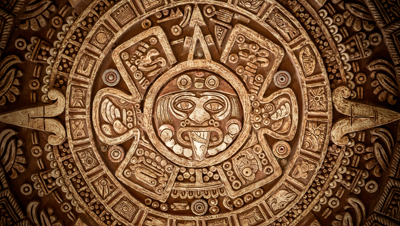
Which Zodiac Signs Will Get A Promotion In 2026?
Discover which zodiac signs are destined for career success in 2026! Find out if you're on the list for a promotion, raise, or major breakthrough.
The Aztecs, just like the Mayans, used three distinct calendars, which led to a very complex form of astrology being formed. This art associates a sign of the day, a sign of the month and a sign of the year! Thanks to 3 ancient calendars, this form of astrology describes your personality and character traits with great precision. According to Aztec beliefs, every individual is protected by a God since birth. It is the day of birth that determines someone's character, talents and future. These Gods are the representation of nature, where we find animals and elements of life.


Like many ancient civilizations, the Aztecs developed their own intricate system of astrology. The Aztec zodiac signs are determined by the Tonalpohualli, a sacred calendar consisting of 260 days. Each day is associated with a glyph and number, which influence a person’s personality and destiny. Unlike modern zodiac systems, Aztec astrology provides individuals with three signs—a day sign, a trecena sign, and an annual sign—to guide their character and spiritual journey.
The Aztec signs astrology system is founded on the idea that every day possesses unique energetic properties that influence a person's fate. The Tonalpohualli calendar, meaning "count of days," was used by the Aztecs to predict events and provide spiritual guidance. Each of the 20-day signs has a specific ruling deity and represents attributes such as leadership, creativity, wisdom, and destiny. This deep-rooted tradition continues to fascinate scholars and astrology enthusiasts today.
Know Your Astro Big 3: The Key to Understanding Yourself & Others
Sun, Moon, Rising: The 3 Pillars of Your Astro-DNA
Unlike Western astrology, where your zodiac sign is determined by your birthdate alone, your Aztec birth sign is calculated using your exact birthdate within the Tonalpohualli calendar. Each day is governed by one of the 20 sacred glyphs, and the number associated with it further refines a person’s fate. The Aztec priests would read these signs carefully, as they were believed to influence a person's spiritual mission, career choices, and personal strengths.
Connect with our gifted experts ✨
👉 Swipe to discover your guide →
⭐ Discover all our gifted advisors
View complete expert directory →Aztec astrology, as its name suggests, comes to us from an ancient South American tribe: the Aztecs, who were particularly fond of astronomy and astrology. Their study of the celestial bodies gave birth to this very precise but also colorful form of astrology, which is based on their own beliefs of the time...
Illuminate your path through 2026 ✨
👉 Swipe to explore your cosmic blueprint →
🌙 Begin your journey into 2026 with clarity and confidence
Aztec astrology is a complex science that uses 3 different calendars:
This system defines periods of 13 days (in the manner of our weeks), to which 20 signs are associated (20 x 13 = 260). Each day is therefore designated by the association of a sign, or glyph, and a figure between 1 and 13, which in turn is associated with a divinity. Certain days can be considered as beneficial or harmful according to the number with which they are associated. This calendar serves to predict the future and the destiny of each one according to his or her day of birth.
The days are grouped, not in 12 lunar months, but in 18 months of 20 days, to which are added 5 days in which the god Nemomtoni or Nemotemi is worshipped. On the twentieth day of each month, and therefore 18 times a year, are celebrated their festivals, during which they proceed to human sacrifices for the salvation of the Earth, according to Aztec belief.
These calendars are in turn part of a longer cycle of 52 years, called Ximolpilli or the Aztec Century, divided into four periods of 13 years, corresponding to the 13 periods of the divinatory calendar. Each of these periods is associated with a figure and a sign, from among the following: Acatl (reed), Tecpatl (flint), Calli (house), Tochtli (rabbit). Because of this cycle, two people born on the same day 52 years apart will have the same sign.

This agreement of the number and the sign of the 52 years is called the "League of the years", the moment in which the Aztecs celebrate the Festival of the New Fire.
The fact that a man who reaches the age of 52 officially enters old age is also noteworthy, it's a symbol of respect and the reason why he is relieved of many obligations such as paying for his rights. His judgment is taken into account, and at that moment he is allowed to drink pulque, a fermented drink based on pita.
To determine your Aztec zodiac sign, it must be calculated according to its date of birth and its correspondence. First take your birth year and the associated number (1904 to 1984 = 18, 1905 to 1985 = 04, 1906 to 1986 = 09 ... etc). Then add the number corresponding to the month of birth (January = 19, February = 10, March = 18, April = 09...). And finally, add the whole with the number of your day of birth (the 8 if you were born on the 8th). The result must be between 1 and 20 (if not, divide it by 20). And here it is: this number corresponds to your Aztec sign! If, for example, you fall on the 8th, you are a "rabbit" (prone to anxiety, shyness, and hating conflicts).
In any case, that day is not added unless it coincides with a period of 104 years that the Aztecs call "old age". This union is made only once every two years at the end of a cycle of 52 years plus one day every 104 years. At the end, 12 days are added every 52, 1 day every 104 years and 1 day every 520 years.
An Aztec year therefore gives: 365 + 12/52 + 1/104 + 1/520 = 365.2423 days. This precision is remarkable since it takes into account the fact that the year of the seasons that separates the two spring equinoxes has a varied duration, corresponding to a tropical year, that is:
The signs are each associated with a direction.
Susan Taylor’s insights: Decipher your personalityThere's so much information out there about our personalities, but it is not always easy to decipher it, and understand what it really means. If you have questions about your future, if you need answers, don't hesitate to make an appointment with one of our psychics. They will enlighten you about your future with great attention. - The future is mine - |
More content:

Discover which zodiac signs are destined for career success in 2026! Find out if you're on the list for a promotion, raise, or major breakthrough.

Taking a look at the predictions for each sign, it would be difficult to contest the fact all 12 are in line for a prosperous year. With the Saturn-Pluto conjunction now being over, we're all set to benefit from increased luck, optimism and a sense of adventure. However, that being said, this year will certainly have its highs and its lows, so discover which month of 2026 will be the worst for your zodiac sign and the reasons why it will be so disastrous 🤯.

This year, Jupiter will be in Taurus, meaning each of the zodiac signs will have its fair share of opportunities to create its own success. Indeed, success is within arm's reach for each of us, but the question is, how do we grab it? Well, the answer is simple, seizing amazing opportunities comes down to surrounding yourself with a lucky color. That's right, in 2026, identifying prosperous shades will be our secret weapon when it comes to achieving our personal initiatives and objectives. So, what are you waiting for, incorporate as much red, yellow, and white into your life as possible this year, because they are the luckiest colors!

Black Moon: unseen in the sky, revealed in natal charts. It influences you greatly. What is its impact on your life?

Gemini, Aquarius, Sagittarius: discover why these 3 signs will quit everything in 2026! Radical change, freedom and renewal on the agenda.

Discover which zodiac signs will experience true love in 2026! Cosmic predictions, coaching tips, and mantras for your heart's transformation.
Técpatl is rather referring to obsidian than flint; I´d say.
MS, 6 years ago
Tecpatl = Flint, Obsidian = Itztli
Richie, 3 years ago